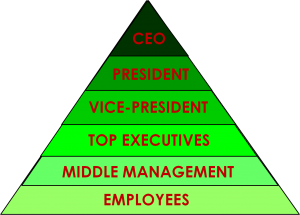When we think of the archetypal business model, we think of a pyramid with the CEO up top then tiering down to upper management, then the managers, then the front-line workers. The more difficult the decisions, the higher up it must be passed along to be decided. What we get with this model is an entire front line of people unwilling and unable to make decisions while forcing the upper tier(s) to spend all their time thinking for others instead of planning. So how do we avoid this?
Empowering People
When we examine businesses that thrive and those that collapse, we see some that are clinging to the hierarchy described above while the start-ups that seem to be taking over the world are thriving. We are seeing this because the start-ups are much more nimble, and now that they are able to attain cash up front from VC’s (venture capitalists) they can afford to bring on other great minds to work alongside them that share their passion.
When this happens, the smart people that started the company are able to focus on growth because they can hire other smart people to surround themselves with. Since they are surrounded by capable people, they don’t need to make decisions for them and the founders can focus on growth. They empower their people to make decisions and trust that they will make the right ones, allowing start-ups to make fast decisions. Meanwhile in corporate America, time is wasted passing the buck up the ladder like an a scene from Atlas Shrugged.
Hire for Quality, not to fill Space
So we know that fast organizations have few tiers and they empower their front line people to make as many decisions as possible. That’s great, but how do we get those people that are responsible enough for us to trust? Don’t skimp on the hiring process.
Spend some time and money up front to save headaches in the long run. Be picky about who you want to work with. Do they mesh with the team? Can they solve problems? Can they think on their feet? Be sure to have all these questions answered before they are brought on. It’s going to cost a little more, but it’s going to be worth it. The older I get the more I realize that the cheapest isn’t always the best.
Training
But Mike, it’s too hard, I don’t have that kind of time or money.
First off, yes we can, I guarantee that we haven’t used all the tools at our disposal. Have we ever dropped what we were doing and put ‘HIRING’ at the top of our to-do list above all else? Use some of that fancy internet I talked about above to find some online resources and dabble in social media since you’re now a master at of.
Secondly, if we can’t find them, make them. I spoke at length about investing in our people and the benefits of doing so (ironically, that came from one of the most stringent hierarchy systems, the US armed forces) back in November. What is it we want our people to know?
- Effective customer service tactics
- How to upload pictures to a website
- Improved closing ratios on sales calls
- Standard accounting practices
- How to use Microsoft Excel
Most skills in the workplace are learn-able things, but we must take the time to teach people up front if we want to save ourselves the hassles in the long run. Set up work-shops and teach people on the job or give them paid OT to come and learn. They will appreciate the investment we make in them and will be more eager to perform for us. Most people are inherently smart, unfortunately we don’t give them the opportunity to prove it to us.
If it were too hard the entire collegiate athletics system outside of Division 1 would crumble. Coaches deal with this and thrive in situations because they use the resources at their disposal to the best of their abilities, they cannot make excuses. The only difference is that their success if much easier to identify: W or L.
 Reprimanding
Reprimanding
When we give our people this much responsibility, they’re going to make mistakes. They will handle something differently than we expect, they will drop the ball, and ultimately the company will take a step back because of it. BUT, if we are prepared for it and if we have built a culture of learning, we can learn from it properly.
It will be crucial for their development that we handle their mistakes properly. Second guessing their every move only after it is made is not the way to encourage growth. Giving them as much information as possible up front and then teaching as they go is the best way to build their confidence. Don’t just tell them what they did wrong, encourage them when they do right as well.
Using a ‘reprimand sandwich’ as I heard it referred on Dave Ramsey’s Entreleadership Podcast is the best way to keep spirits high, while pointing out mistakes. Sandwich a reprimand for a mistake in between two positives for the most effective way to teach a new person. Everyone reacts differently, but this is the safest when dealing with a new person that is still building confidence.
Take the time to learn how your people learn so that you can teach them best. And learn how they respond to criticism as well, some people thrive by being publicly reprimanded and others will quit on the spot for something like that. Everyone is different, it is our job as leaders and managers to figure that out.
Remember that the goal is to make our organizations fast by empowering out people to make decisions, this will allow us to spend our time planning for the future so we can grow our businesses.
—
Does your organization put decision making in the hands of your front line people? What are the positives and negatives associated with this type of management?
Leave me a comment or connect with me on Twitter, I’d love to hear your thoughts on this follow-up technique!
P.S. 7 Days till Christmas!

